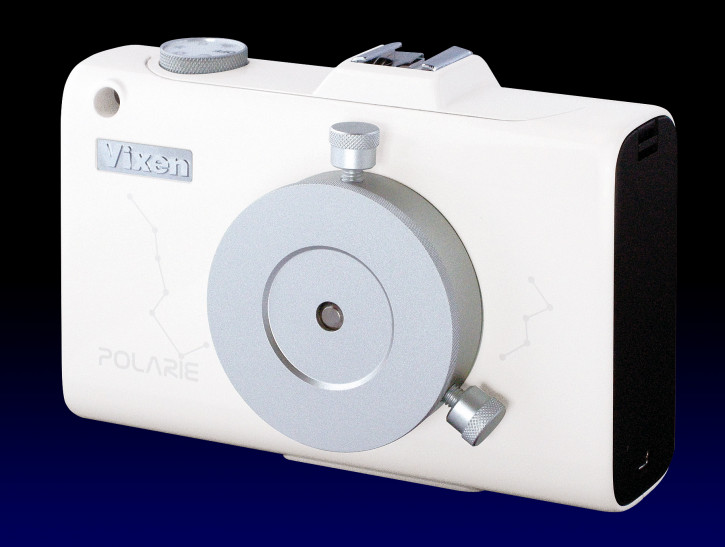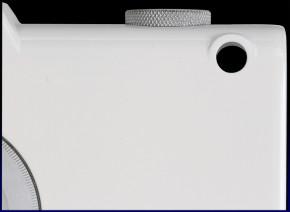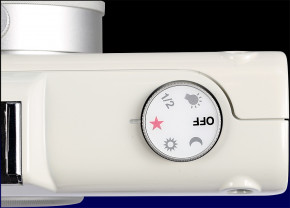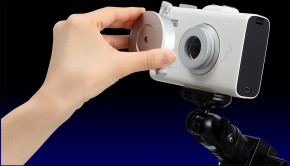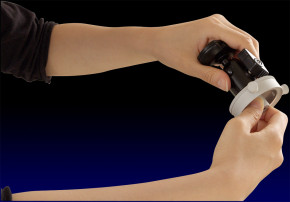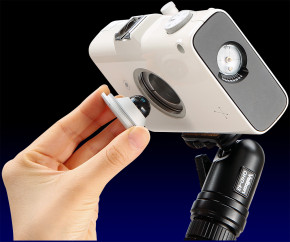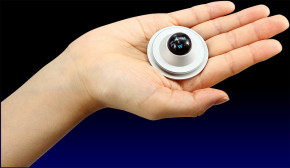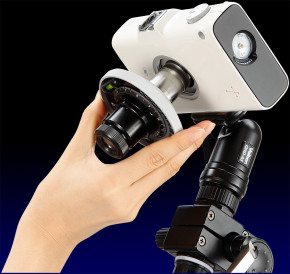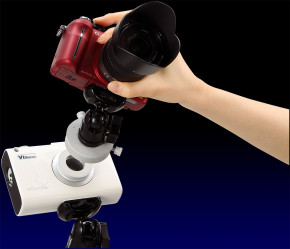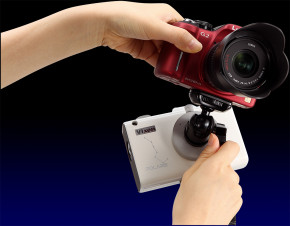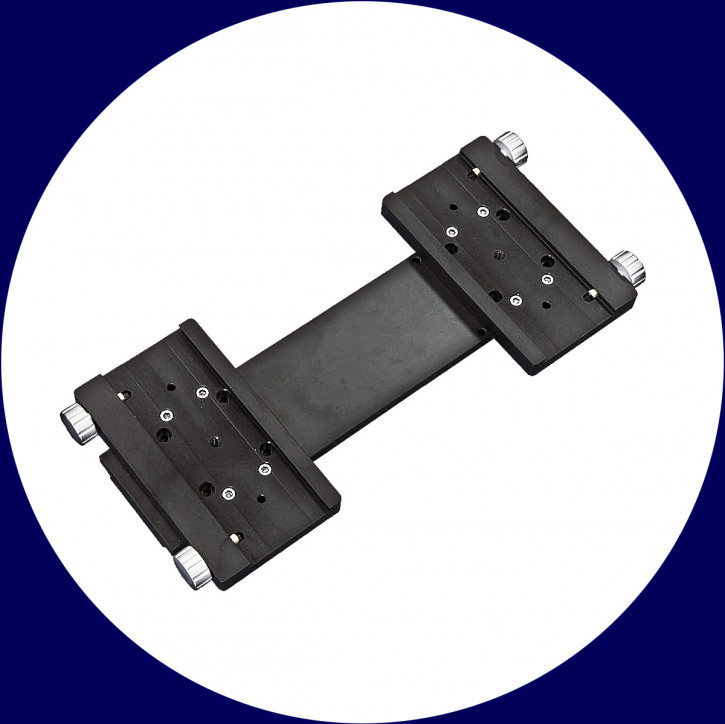Vixen POLARIE Star Tracker Mount
Product.Nr.:
VE#35505
EAN: 4955295355051
products condition: new
Manufacturer: Vixen
419,00 EUR
incl. 19 % VAT
- Taking photos of the night sky has never been easier!
- Easily allows you to take pinpoint photos of stars and constellations
- Taking wide filed photographic images of constellations, the Milky Way, shooting stars and bright comets is surprisingly simple and easy
- "Star-Scape" photography
- Camera, Ball Head, Tripod, USB-cable, Polar Axis Scope are NOT included!
What is Polarie?
The Vixen Polarie is a totally new photographic accessory which easily allows you to take pinpoint photos of stars and constellations. It is designed to follow the apparent motion of the stars caused by the earth's rotation, eliminating star trails.
With use of the Polarie, taking wide filed photographic images of constellations, the Milky Way, shooting stars and bright comets is surprisingly simple and easy.
Polarie also enables you to photograph starry nightscapes by adding a night landscape or silhouetted figure in the foreground of your frame. We name it "Star-Scape" photography.
Let's begin "Star Scape" Photography with the POLARIE
Features
- The POLARIE sets up in less than a minute, even for users not familiar with the direction of the celestial pole at your location. Simply turn the Polarie in the direction of the Polestar in the northern hemisphere (or south celestial pole in the southern hemisphere) using the compass, tilt-meter and polar sight hole that are all provided with the POLARIE.
- The POLARIE is designed to work with your photographic lens that takes wide-angle shots of constellations.
- The POLARIE can work for more than 2 consecutive hours with two AA-size alkaline batteries.
- You can take the ultra-compact and lightweight Polarie anywhere with you to creating stunning images of the night skies and "Star-Scapes".
How to Use the POLARIE
Preparation
Remove the battery compartment cover on the side of the POLARIE and insert two fresh AA-size batteries into the battery compartment. The tracking direction (N-S change switch) is set to use in the northern hemisphere. Switch it to S when Polarie in the southern hemisphere.
Setting up and Polar Alignment
(1) Attach the POLARIE to a sold camera tripod securely with the 1/4" threaded screw.
(2) Remove the camera mounting block on the front of the POLARIE by loosening the two thumb screws on its side.
(3) Attach a commercially availble Ball head adapter firmly on the camera mounting block. (The Ball head adapter is supplied as standard accessory if you purchased as a package of Polarie and tripod.) Then, attach the camera on the Ball head adapter.
(4) Set up the POLARIE-mounted tripod on a level ground where you can view the polar star and the area of sky you want to photograph.
(5) Take off the compass from the back of the POLARIE. Locate north with the compass and slew the Polarie on the tripod toward the north (in northern hemisphere.)
(6) Set the mode dial to preparation mode on the top of the POLARIE. With watching the tilt mater on the side of the Polarie, tilt the POLARIE until the tilt meter points the latitude of your location.
(7) Look through the polar sight hole and locate the polar star so that it is placed in the center of the field of view.
(8) Attach the camera mounting block with the camera to the front of the POLARIE. Set the mode dial to either star-scape photography mode or wide-field astrophotography mode according to your intention. All is ready and turn the camera to the area of night sky you want to photograph.
FAQ
Q1: What digital cameras are suitable for taking wide field celestial photography with the POLARIE?
A1: It is essential that a digital camera for astrophotography has the ability of opening a shutter for a long period of time and setting a focus at infinity.
Use of a DSLR camera (digital camera with intershangeable photographic lens), which has functions to control the focus, shutter exposure times and lens apertures manually, is recommended.
Q2: What equipment is required besides the POLARIE?
A2: A stable camera tripod and a ball head adapter, on which to attach the camera to the POLARIE, are required. In addition, a shutter release (remote) cable is needed to avoid vibration.
Q3: What photographic lenses are suitable for the POLARIE?
A3: Generally it is advisable to use a wide-angle photographic lens. The wide-angle photographic lens offers a wide frame and it is suitable for taking photos of whole constellations and the Milky Way. With the longer shutter exposure, star trails are less conspicuous in the wide frame of the wide-angle photographic lens even if the polar setting of the POLARIE is not precise. The longer the focal length of a photographic lens, the shorter the exposure time that allows pinpoints star images. As a result, more accurate polar setting is required when using a telephoto lens.
Q4: What should I consider to determine the shutter exposure times?
A4: Generally you need to take into account the brightness of the sky' background, ISO speed setting and value of the aperture stop of your DSLR camera to determine the proper duration of exposure.
When using the POLARIE in urban areas, acceptable exposure times will be shorter. When using the POLARIE at a remote rural site, longer exposure times will be possible. How long you can go depends on how dark your sky is. The faster the ISO speed you set, the higher the light sensitivity your camera gains with a given time of exposure. This allows you take photos of many faint stars you cannot see with the naked eye but the trade-off is an increase in electronic noise on captured images that comes from the faster ISO speed. In addition, wider lens aperture (smaller F-number) allows for shorter exposure time, but it can result in distorted stars in the corners of the frame.
The table below shows recommended maximum exposure times to deliver pinpoint star images with use of 3 photographic lenses of different focal lengths from wide-angle to standard. In the table the Polarie is aligned at a tolerance of 2 degrees from the celestial poles. It is almost the same accuracy for polar alignment when you align Polaris into the polar sight hole of the POLARIE.
| Focal Length (Regardless of the CCD imaging size.) |
Stars on the Celestial Equator | Stars on Declination at ±60° |
| 15mm | 6 minutes 52 seconds | 13 minutes 45 seconds |
| 24mm | 4 minutes 17 seconds | 8 minutes 35 seconds |
| 35mm | 2 minutes 56 seconds | 5 minutes 53 seconds |
Note: The above exposure times are calculated on the assumption that the pixel size of an imaging device is 0.001mm.
Because the apparent motion of stars differs at various areas of the sky, you view the stars as they turn around the celestial pole. This decreases as your camera is turned toward the celestial pole and the exposure times increase. Note, the shorter the focal length, the longer the exposure time.
Q5: What is the 1/2 sidereal tracking mode on the POLARIE?
A5: It is used to take "Star-Scape" photos in which you add a foreground image such as a nightscape or silhouette of landscape to your frame of the starry sky.
In the celestial tacking mode, the camera follows the motion of stars and the stars are recoded as tiny dots on the CCD imagers, but landscape and silhouette are trailed. Contrary, photography with a fixed camera-on-tripod will generate streaks of stars for short exposures. The half speed of the celestial tracking mode allows you to extend the shutter exposure times so that you can keep the stars pinpoint while minimizing the motion of the nightscape or silhouette of landscape in the frame. The faster ISO setting can also help avoiding star trails. This mode is suitable for "Star-Scape" photography with the use of wide-angle lenses.
| POLARIE Specifications | |
| Dimensions | 137 mm x 95 mm x 58 mm |
| Weight | 744g (26.2 oz) |
| Power source | 2 AA-size alkaline batteries |
| External power supply | USB mini-B connection (4.4 to 5.25 volt) |
| Tilt-meter (Angle) | 0 to 70 degrees (5-degree increments) |
| Compass | A margin of error is subject to magnetic declination at your location. |
| Polar sight hole | About 8.9 degrees field of view |
| Drive | Stepper motor |
| Tracking mode selector | Sidereal, 1/2 sidereal (star-scape), solar and lunar, usable in both hemispheres |
| Tripod socket | 1/4" -20 |
| Maximum payload capacity | 2 kg (4.4 lb) |
Delivered by order
- Vixen POLARIE Star Tracker Mount
(Body only!)
Camera, Ball Head, Tripod, USB-cable, Polar Axis Scope are NOT included! - Manual
All optional accessories not included!
Manufacturer identification
Manufacturer identification
Name: Vixen Co., Ltd.Streetaddress: 5-17-3 Higashi-Tokorozawa Tokorozawa-shi
ZIP Code: 359-0021
City: Saitama
Country: JP
Phone: 04-2944-4000

